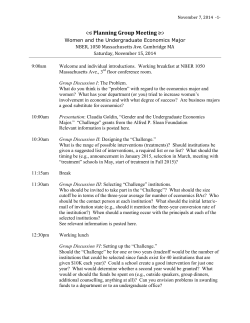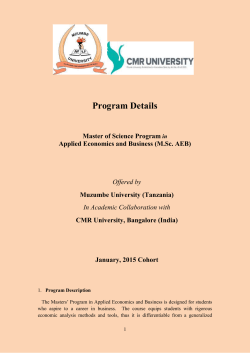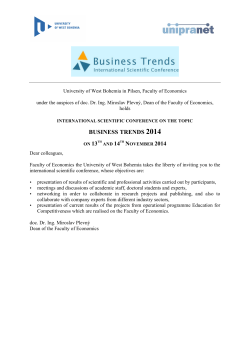
SEEM2440 Engineering Economics
SEEM2440 Engineering Economics Tutorial 2 Guo Weiwei Guo Weiwei (CUHK) SEEM2440 Engineering Economics 1 / 12 Interest Rate Simple interest rate I =P ×N ×i Compound interest rate I = P((1 + i)N − 1) Nominal interest rate: r Effective interest rate: i M compounding period in a year i = (1 + Guo Weiwei (CUHK) r M ) −1 M SEEM2440 Engineering Economics 2 / 12 Factor symbols, formulas and names Symbols (F/P,i,N) Formula (1 + i)N Name future value factor or compound factor (P/F,i,N) 1 (1+i)N present value factor or discounting factor (F/A,i,N) (1+i)N −1 i annuity future value factor −N (P/A.i.N) 1−(1+i) i annuity present value factor (A/F,i,N) i (1+i)N −1 F to A conversion factor (A/P,i,N) i 1−(1+i)−N P to A conversion factor (F/G,i,N) (P/G,i,N) N 1 (1+i) −1 i[ i 1 1−(1+i) i[ i Guo Weiwei (CUHK) − N] −N − N ] (1+i)N arithmetic gradient future value factor arithmetic gradient present value factor SEEM2440 Engineering Economics 3 / 12 Question 1 A good stock-based mutual fund should earn at least 10% per year over a long period of time. Consider the case of Barney and Lynn, who were overheard gloating about how well they had done with their mutual fund investment. ”We turned a $25,000 investment of money in 1982 into $100,000 in 2007.” a. What annual return (interest rate) did they really earn on their investment. Should they have been bragging about how investment-savvy they were? b. Instead, if $1,000 had been invest each year for 25 years to accumulate $100,000, what return did Barney and Lynn earn? Guo Weiwei (CUHK) SEEM2440 Engineering Economics 4 / 12 Solution Mutual Fund Definition: A mutual fund is a type of professionally managed collective investment scheme that pools money from many investors to purchase securities. Advantages: Increased diversification Daily liquidity Professional investment management Government oversight Guo Weiwei (CUHK) SEEM2440 Engineering Economics 5 / 12 Solution (a) N = 2007 − 1982 = 25 F = P(F /P, i, N) ⇒ 100, 000 = 25, 000(1 + i)25 i = 5.7% So Barnet and Lynn did not really do that well at all. Guo Weiwei (CUHK) SEEM2440 Engineering Economics 6 / 12 Solution (a) N = 2007 − 1982 = 25 F = P(F /P, i, N) ⇒ 100, 000 = 25, 000(1 + i)25 i = 5.7% So Barnet and Lynn did not really do that well at all. (b) 100, 000 = 1, 000(F /A, j, 25) j = 10.1% In this situation they did pretty well on their mutual fund investment. Guo Weiwei (CUHK) SEEM2440 Engineering Economics 6 / 12 Question 2 Automobiles of the future will most likely be manufactured largely with carbon fibers made from recycled plastics, wood pulp, and cellulose. Replacing half the metals in current automobiles could reduce a vehicle’s weight by 60% and fuel consumption by 30%. One impediment to using carbon fibers in cars is cost. If the justification for the extra price of carbon-fiber cars is solely based on fuel savings, how much extra price can be justified over a six-year life span if the carbon-fiber car would average 39 miles per gallon of gasoline compared to a conventional car averaging 30 miles per gallon? Assume that gasoline costs $3.00 per gallon, the interest rate is 20% per year, and 117,000 miles are driven uniformly over six years. Assume fuel costs occur at the end of each year. Guo Weiwei (CUHK) SEEM2440 Engineering Economics 7 / 12 Solution Extra price is the present value of the fuel cost saving in the life span of six years. Miles covered each year: 117, 000 = 19, 500 6 Annual fuel cost saving of carbon-fiber car over conventional car: 3.00 × ( 19, 500 19, 500 − ) = 450 30 39 P = A(P/A, 20%, 6) = 1496.5 Guo Weiwei (CUHK) SEEM2440 Engineering Economics 8 / 12 Question 3 John Smith took out a student loan to complete his four year engineering degree. He borrowed $5000, four years ago when the interest rate was 5% per year. A further $6000 was borrowed 3 years ago at 3% per year. Two years ago he borrowed $6000 at 6% and last year $7000 was borrowed at 8% per year. If Smith makes annual payments to repay his total debt payments up to 10 years with 8% fixed annual interest rate.(Assume repayment starts from now) What is the amount of each payment? Guo Weiwei (CUHK) SEEM2440 Engineering Economics 9 / 12 Solution Guo Weiwei (CUHK) SEEM2440 Engineering Economics 10 / 12 Solution F−3 = 5000(F /P, 5%, 1) + 6000 = 11250 F−2 = 11250(F /P, 3%, 1) + 6000 = 17587.5 F−1 = 17587.5(F /P, 6%, 1) + 7000 = 25642.75 P = F0 = 25642.75(F /P, 8%, 1) = 27694.17 A = F0 (A/P, 8%, 10) = 4126.43 Guo Weiwei (CUHK) SEEM2440 Engineering Economics 10 / 12 Question 4 An auto dealership is running a promotional deal whereby they will replace your tires free of charge for the life of the vehicle when you purchase your car from them. You expect the original tires to last for 30,000 miles, and then they will need replacement every 30,000 miles thereafter. Your driving mileage averages 15,000 miles per year. A set of new tires costs $400. If you trade in the car at 150,000 miles with new tires then, what is the lump-sum present value of this deal if your personal interest rate is 12% per year? Guo Weiwei (CUHK) SEEM2440 Engineering Economics 11 / 12 Solution Guo Weiwei (CUHK) SEEM2440 Engineering Economics 12 / 12 Solution The interest rate for 2 years j satisfies 1 + j = (1 + 12%)2 ⇒ j = 25.44% P = $400(P/A, j, 5) = $1066 Guo Weiwei (CUHK) SEEM2440 Engineering Economics 12 / 12
© Copyright 2025











